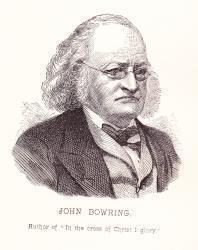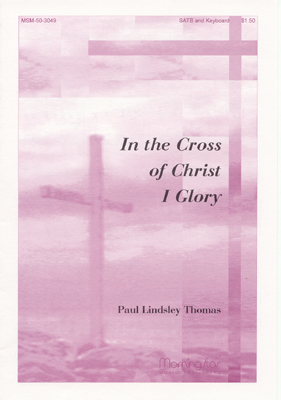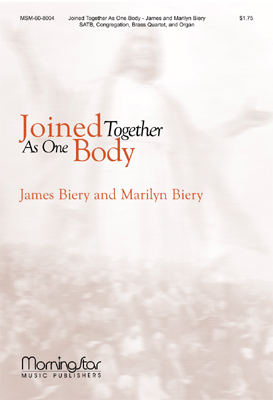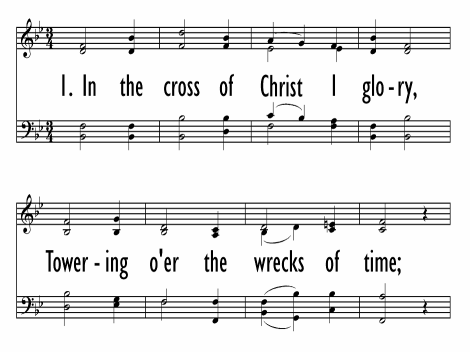- |
User Links
In the Cross of Christ

In the cross of Christ I glory, Towering over the wrecks of time
Author: John Bowring (1825)Tune: RATHBUN
Published in 1548 hymnals
Printable scores: PDFPlayable presentation: Lyrics only, lyrics + musicAudio files: MIDI, Recording
Representative Text
1 In the cross of Christ I glory,
towering o'er the wrecks of time;
all the light of sacred story
gathers round its head sublime.
2 When the woes of life o'ertake me,
hopes deceive, and fears annoy,
never shall the cross forsake me.
Lo! it glows with peace and joy.
3 When the sun of bliss is beaming
light and love upon my way,
from the cross the radiance streaming
adds more luster to the day.
4 Bane and blessing, pain and pleasure,
by the cross are sanctified;
peace is there that knows no measure,
joys that through all time abide.
5 In the cross of Christ I glory,
towering o'er the wrecks of time;
all the light of sacred story
gathers round its head sublime.
United Methodist Hymnal, 1989
Author: John Bowring
 James Bowring was born at Exeter, in 1792. He possessed at an early age a remarkable power of attaining languages, and acquired some reputation by his metrical translations of foreign poems. He became editor of "The Westminster Review" in 1825, and was elected to Parliament in 1835. In 1849, he was appointed Consul at Canton, and in 1854, was made Governor of Hong Kong, and received the honour of knighthood. He is the author of some important works on politics and travel, and is the recipient of several testimonials from foreign governments and societies. His poems and hymns have also added to his reputation. His "Matins and Vespers" have passed through many editions. In religion he is a Unitarian.
--Annotations of the Hymnal, Charl… Go to person page >
James Bowring was born at Exeter, in 1792. He possessed at an early age a remarkable power of attaining languages, and acquired some reputation by his metrical translations of foreign poems. He became editor of "The Westminster Review" in 1825, and was elected to Parliament in 1835. In 1849, he was appointed Consul at Canton, and in 1854, was made Governor of Hong Kong, and received the honour of knighthood. He is the author of some important works on politics and travel, and is the recipient of several testimonials from foreign governments and societies. His poems and hymns have also added to his reputation. His "Matins and Vespers" have passed through many editions. In religion he is a Unitarian.
--Annotations of the Hymnal, Charl… Go to person page >Text Information
Related Texts
| First Line: | In the cross of Christ I glory, Towering over the wrecks of time |
| Title: | In the Cross of Christ |
| Author: | John Bowring (1825) |
| Meter: | 8.7.8.7 |
| Language: | English |
| Notes: | Spanish translation: See "En las excelsa cruz de Cristo" by Speros Demetrius Athans |
| Copyright: | Public Domain |
- Year A, Epiphany Season, Fourth Sunday
This is recommended for Year A, Epiphany Season, Fourth Sunday by 3 hymnal lectionary indexes including Glory to God: the Presbyterian Hymnal #213. - Year A, Holy Week season, Tuesday of Holy Week
This is recommended for Year A, Holy Week season, Tuesday of Holy Week by 2 hymnal lectionary indexes including Glory to God: the Presbyterian Hymnal #213. - Year B, Lent, Third Sunday
This is recommended for Year B, Lent, Third Sunday by 3 hymnal lectionary indexes including Glory to God: the Presbyterian Hymnal #213. - Year B, Holy Week season, Tuesday of Holy Week
This is recommended for Year B, Holy Week season, Tuesday of Holy Week by 2 hymnal lectionary indexes including Glory to God: the Presbyterian Hymnal #213. - Year C, Lent, Second Sunday
- Year C, Holy Week season, Monday of Holy Week
- Year C, Holy Week season, Tuesday of Holy Week
This is recommended for Year C, Holy Week season, Tuesday of Holy Week by 2 hymnal lectionary indexes including Glory to God: the Presbyterian Hymnal #213. - Year C, Ordinary Time, Proper 9 (14)
English
- 112 Familiar Hymns and Gospel Songs #85
- 52 Hymns of the Heart: with an appendix of favorite solos and choruses (Missionary and Church Extension Ed.) #37
- A Book of Hymns for Public and Private Devotion (15th ed.) #145
- A Book of Hymns for Public and Private Devotion. (10th ed.) #145
- A Collection of Choral Hymns for the ... Hanson Place Methodist Episcopal Congregation #d89
- A Collection of Evergreen Hymns, for All the People. New ed. #d70
- A Collection of Hymns and Sacred Songs: suited to both private and public devotions, and especially adapted to the wants and uses of the brethren of the Old German Baptist Church #509
- A Collection of Hymns, for the Christian Church and Home #193
- A Collection of Hymns, for the use of the United Brethren in Christ: taken from the most approved authors, and adapted to public and private worship #676
- A Collection of Psalms and Hymns for Christian Worship. (45th ed.) #640 10 shown out of 1122
Welsh
Notes
Access an additional article on the Canterbury Dictionary of Hymnology:
Tune
RATHBUNThis story is associated with the writing of RATHBUN: One Sunday in 1849 Ithamar Conkey (b. Shutesbury, MA, 1815; d. Elizabeth, NJ, 1867) walked out of the morning service at Central Baptist Church, Norwich, Connecticut, where he was choir director and organist, frustrated because only one soprano f…
For Leaders
Text:
John Bowring was an Englishman whose career was in business and government. He was also a Unitarian. As such, it is somewhat surprising that he wrote such a hymn as “In the Cross of Christ I Glory,” since Unitarians do not believe that Jesus Christ was divine. In 1825, Bowring published the hymn in his Hymns in London.
The themes of this hymn are the glory of the cross, and the peace and joy that can be found through it in the toils and joys of life. While the hymn originally had five stanzas, the fifth is merely a repetition of the first and is usually omitted.
Tune:
The most popular tune for this hymn is RATHBUN, composed by Ithamar Conkey in 1849, while he was organist at Central Baptist Church in Norwich, Connecticut. One story associated with this tune is that one Sunday, only one soprano showed up for the choir, so a discouraged Conkey left the service after the prelude. That afternoon, in a different frame of mind, he wrote this tune and named it for the one faithful soprano, Mrs. Beriah S. Rathbun.
When/Why/How:
This hymn is suitable for Lent or Holy Week, as well as for a Communion service. The slow tempo and meditative quality of the tune make this hymn a good choice for instrumental music during Communion or as a prelude for Lent or Good Friday. “Two Meditations on The Cross” is an arrangement of RATHBUN and NEAR THE CROSS for handbells. For organ, try “Toccata on In the Cross of Christ I Glory” or the setting of RATHBUN found in “Hosannas and Alleluias.” “These Forty Days” contains an arrangement of this hymn for organ and piano duet.
Tiffany Shomsky, Hymnary.org
Timeline
Arrangements
Media
Psalter Hymnal (Gray) #474
The United Methodist Hymnal #295
- MIDI file from Baptist Hymnal 1991 #554
- Audio recording from Baptist Hymnal 1991 #554
- MIDI file from Baptist Hymnal 1991 #554
- Audio recording from Baptist Hymnal 2008 #247
- Audio recording from The Celebration Hymnal: songs and hymns for worship #328
- MIDI file from The Christian Sunday School Hymnal: a compilation of choice hymns and tunes for Sunday schools #96
- MIDI file from The Cyber Hymnal #3006
- Audio recording from Evangelical Lutheran Worship #324
- Audio recording from Glory to God: the Presbyterian Hymnal #213
- MIDI file from Psalter Hymnal (Gray) #474
- MIDI file from Psalter Hymnal (Gray) #474
- Audio recording from Small Church Music #285
- Audio recording from Small Church Music #285
- MIDI file from Triumphant Songs No.1 #83
- MIDI file from The United Methodist Hymnal #295
- Audio recording from The United Methodist Hymnal #295
- Audio recording from Worship and Rejoice #264
- MIDI file from Worship and Rejoice #264


 My Starred Hymns
My Starred Hymns






